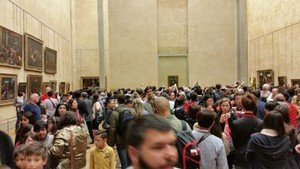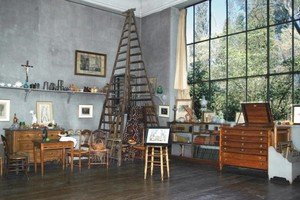Object labels vs Audio guides
2015 has been a hot and sticky summer in Europe as a heatwave swept the continent in late June and early July, smashing both monthly and all time temperature records. I was lucky enough to be granted leave from my job at Story Inc (thanks James and Steve!) to travel for 10 weeks around Europe. And so as the mercury climbed so did the appeal of the many museums, galleries and visitor experiences on offer due to their powerful air-conditioning systems. I took refuge from the heat in a diverse range of institutions ranging from traditional large-scale museums and galleries, to more modern technology driven experiences and then more simplistic small-scale yet evocative establishments.
Mention ‘Europe’ and ‘Museum’ in the same sentence and it’s likely that the first that springs to mind is Paris’ iconic Louvre. Despite the futuristic looking pyramid entry point, the entire experience can be considered about as traditional as museums come. Little to no interpretation other than object labels gives visitors the freedom to draw their own conclusions about the treasures on display. However, as many seem to head straight into the crush of bodies around the Mona Lisa and then immediately for the next exit it seems unlikely that visitor engagement goes beyond collecting the “trophy” of a selfie with Da Vinci’s famous muse. Other museums that I visited which also fit this traditional or classical museum mould were the Uffizi in Florence and the British Museum in London. What these power house museums lack in terms of modern interpretation techniques they more than make up for in history rich objects on display, hence the long queues of tourists from opening until close every day in the summer.
Younger museums with large and fascinating, but not as valuable or historically important collections, seemed in some ways to be attempting to emulating the classical museums but still incorporating modern interpretation techniques. The most effective museums that I visited that I would class in this category were the Wellcome Collection in London and the Van Gogh Museum in Amsterdam.
Despite their differences in terms of subject matter these two institutions have both adopted a progressive approach to technology with handheld devices (adapted smartphones) which allow visitors to learn more about selected collection items with audio, video and even interactive quizzes or challenges connected via a simple numbering system. There were several advantage to this system that I observed. The first was that graphic panels are limited, allowing visitors to learn in a variety of ways rather than purely by reading information. Also, unlike many standard audio guides which run through one continuous audio reel exploring many objects or art works, visitors retain the freedom to pick and choose which objects to learn more about and can linger at works or move at pace. Searching through the gallery for the next numbered item which can be explored further through your device has a treasure-hunt type feeling to it which adds to the fun!
The final tier of museum that I frequented on my travels is what I have named the simple but intimate experience. Lacking the palatial splendour and “big ticket” items of the classical museums these experiences do not attempt to make up for it with flashy modern interpretation techniques or technology. Instead they form an emotional connection with the visitor, usually as a result of their evocative setting. Examples of this type of experience are: Cézanne’s Atelier in Aix-en-Provence – his studio complete with all of his belongs in situ giving the impression that he has just stepped out momentarily; Anne Frank House in Amsterdam – the house that Anne and her family and some of their friends hid from the Nazis within; Monet’s Garden in Giverny – complete with the famous lily ponds with their arched Japanese style bridges; and the small museum in Saint Cyril and Methodius Church in Prague – the hiding place for seven Czech parachutists following their assassination of the Reich governor of Bohemia and Moravia and architect of ‘the final solution’ Reinhard Heydrich during WWII. With the exception of Anne Frank House, these experiences are further off the beaten track and usually not as well publicised as the larger museums and galleries. However, they offer powerful experiences in their own right and offer lessons for institutions on connecting with visitors on a deeper, emotional level.





